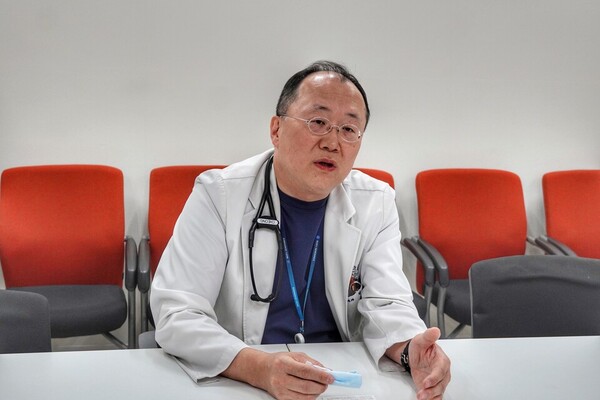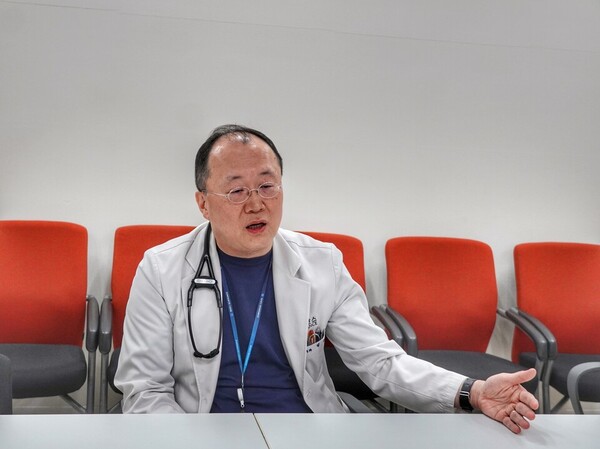Acute myeloid leukemia (AML) is a blood cancer in which white blood cells of the myeloid lineage become malignant, increase in the bone marrow, and spread throughout the body. Treatment-related AML (t-AML) and AML with myelodysplasia-related changes (AML-MRC) are classified as high-risk AML and are associated with a poor prognosis.

The standard of care for AML has been an intensive chemotherapy regimen called the “7+3 regimen” for the past half century since the 1970s. It consists of three days of an anthracycline drug and seven days of cytarabine.
High-risk patients were also treated with this regimen, but the lack of suitable drugs for those who cannot tolerate intensive chemotherapy has been a challenge.
Against this backdrop, Vyxeos Liposome Inj (daunorubicin + cytarabine) won approval in Korea in November 2022. Vyxeos is a liposomal formulation of daunorubicin and cytarabine in a 1:5 molar ratio used in 7+3 therapy, which is characterized by a longer residence time in the bone marrow and a more concentrated effect in leukemia cells than in normal cells.
Vyxeos is the first agent approved to treat t-AML and AML-MRC. Recently, the Health Insurance Review and Assessment Service (HIRA) approved coverage of Vyxeos for first-line remission induction therapy and remission consolidation therapy for newly diagnosed t-AML or AML-MRC in adults aged 60 and older. It will go into effect on Dec. 1.
In a direct comparison of Vyxeos and conventional 7+3 therapy, overall survival was prolonged from six months to 9.6 months, and complete remission rates increased from 33 percent to 48 percent. Survival rates were 42 percent at one year (previously 28 percent), 31 percent at two years (previously 12 percent), and 18 percent at five years (previously 8 percent). The hematopoietic stem cell transplant rate was 34 percent (previously 25 percent). The dosing schedule was changed from 24 hours over seven consecutive days to four hours on days one, three, and five, and the safety profile was similar to the previous treatment.
Korea Biomedical Review interviewed Professor Cheong June-won of the Department of Hematology at Severance Hospital, who also chairs the Korean Society of Hematology's Acute Myeloid Leukemia/Myelodysplastic Syndromes Research Committee, to learn about the current state of acute myeloid leukemia treatment and the changes the new treatment will bring.
Question: What are the characteristics of acute myeloid leukemia?
Answer: Leukemia is divided into two main types -- acute and chronic. Within acute leukemia, there are acute myeloid leukemia (AML) and acute lymphoblastic leukemia (ALL), which are related to the differentiation process of blood stem cells. In the past, chronic myeloid and chronic lymphoblastic leukemia were considered together. When blood is made from stem cells, it is divided into the myeloid and lymphoid systems and acute leukemia is divided into the lymphoid and myeloid systems. Characteristically, ALL is more common in children, while AML is more common in adults.
Q: In which cases are they classified as high-risk AML?
A: The European Leukemia Network (ELN)'s guidelines are the most widely used risk classification. This classification is based on the presence or absence of chromosomal abnormalities and the resulting mutations. The same type of leukemia can have different prognoses for different patients. For example, older patients may have a harder time tolerating treatment than younger ones or have different underlying medical conditions. This is due to differences in the patient's condition, not differences in the leukemia cells.
Notably, patients with myelodysplastic syndromes are more difficult to treat. That’s because they are usually in their late 60s and have a variety of genetic mutations accompanying them. As a result, they often have a poorer prognosis than AML, which occurs in younger patients.
Q: How has high-risk AML been treated so far?
A: The same treatment principles have been applied to all patients with AML. First, we evaluate whether the patient can tolerate chemotherapy and whether a transplant is possible. If both are possible, we proceed with high-intensity chemotherapy followed by an allogeneic stem cell transplant. Depending on the patient's condition, low-intensity chemotherapy may be chosen, and allogeneic stem cell transplantation may not be performed. In other words, for any type of high-risk acute myeloid leukemia, the treatment is based on the patient's condition.
Q: Describe the 7+3 regimen, which has been the standard of care for half a century.
A: The 7+3 regimen is a common and classic chemotherapy regimen. As with most cancer treatments, it uses a combination of drugs, and acute myeloid leukemia is no different. This means one drug is given for seven days and the other for three days. However, this treatment may not be used if the patient's condition is too poor to tolerate high-intensity chemotherapy.
Q: Which patients had difficulty with conventional treatments?
A: First, AML has a large unmet need. For younger patients, it is easy to develop and implement a treatment plan, but for older patients 70 and older and those who are in poor health after other cancer treatments, it is difficult to apply standard treatment regimens and expect high cure rates.
Q: How does Vyxeos compare to existing treatments as a new option?
A: Until now, patients with AML have been treated with either conventional therapy or, if chemotherapy is not feasible, low-intensity therapy. Vyxeos is helpful in both cases. It works better than the traditional 7+3 regimen, allowing patients to achieve better outcomes, and it gives patients who would otherwise only be able to receive low-intensity therapy the opportunity to receive standard treatment.
In addition, the two agents in the 7+3 regimen have been enhanced with liposomal formulations to improve therapeutic efficacy and shorten the dosing period. Instead of requiring 24 consecutive hours of dosing over seven days, Vyxeos only requires four hours of dosing on days one, three, and five.
Q: Are there any precautions when prescribing Vyxeos?
A: There are no additional precautions. You can follow the same precautions as you would with any high-intensity chemotherapy. Since most chemotherapy drugs target cancer cells that divide faster than normal cells, there is a concern about damage to normal cells, but Vyxeos has improved this. It has the same ingredients as the existing 7+3 regimen but has been improved to be more efficient and safer to administer.
Notably, patients who are difficult to treat with existing drugs, such as those with underlying blood disorders or those who cannot tolerate high-intensity therapy, can now receive the necessary components at a lower dose.
Q: How many people will be treated with Vyxeos?
A: The number of patients who need Vyxeos is expected to grow. In particular, the number of eligible patients may increase as more patients survive long-term after cancer treatment. While some cases may end with simple surgery, more patients are receiving additional treatments, such as chemotherapy and radiation, than ever before. Currently, there are about 2,500 new cases of AML and 1,000 cases of myelodysplastic syndromes every year, and the number of myelodysplastic syndromes will continue to increase due to the population aging, which will increase the number of patients eligible for Vyxeos. We estimate that 10-20 percent of all leukemia patients will be affected.
Q: How have patients responded to Vyxeos?
A: Patients treated with Vyxeos particularly appreciate the convenience of dosing. The traditional 7+3 regimen requires patients to take one component 24 hours a day for seven days and the other for three days, which can be overwhelming. Vyxeos is much simpler to dose, and while cost has limited prescribing before reimbursement, with insurance coverage, there is no reason to stick with the 7+3 regimen developed half a century ago. The main reasons for choosing this agent are the shorter duration and improved efficacy.
Q: We are also curious about the role of Vyxeos in treating AML.
A: Vyxeos is licensed for a very specific indication. All patients with this indication are eligible for treatment. It's important to note that the patients eligible for Vyxeos are a high-risk group.
AML does not end with a single treatment but requires a multi-step process. First, remission is induced, and then transplantation is performed to cure the disease, but without remission, transplantation is not possible. So, we treat prioritizing remission as the first goal, and Vyxeos improves patient outcomes and increases their chances of progressing to the next stage. In AML, taking the first step right before moving on to second and third-line treatments is even more critical.

Q: What are the most pressing challenges in blood cancer treatment today?
A: The most pressing issue is the severe shortage of hematologists. Currently, only about three specialists graduate annually in the country. According to 2021 data, there are about 270,000 new cancer cases per year, of which blood cancer accounts for about 20,000. Moreover, blood cancers are growing faster than other solid cancers. The number of leukemia patients continues to increase, and there are not enough doctors to treat them. Pediatric hematologic malignancies are the most challenging.
We also need to improve the speed at which new drugs become available. New drugs that are proven to help patients should be reimbursed faster. If a drug is approved, it should be fast-tracked. Cancer is a life-threatening disease, and delays can be very hard on patients. We hope that new drugs developed in the future will be reimbursed more quickly.
The Korean Society of Hematology is also trying to establish the Acute Myeloid Leukemia/Myelodysplastic Syndromes Research Committee. However, there is a limit to the amount of input that can be gathered and communicated. This is true for AML and new drugs in the field of blood cancers in general.
Q: What is your advice to patients who are going through a difficult treatment process?
A: Acute myeloid leukemia is a cancer that requires a long course of treatment. Other cancers have long-term treatments if things don't go well, but leukemia has a long treatment plan from the start. Patients need to have the will to persevere, know that they have other treatment options if they don't get good results at each treatment stage, and be positive and accepting of that. It is a disease that requires an “unbreakable mind.”

